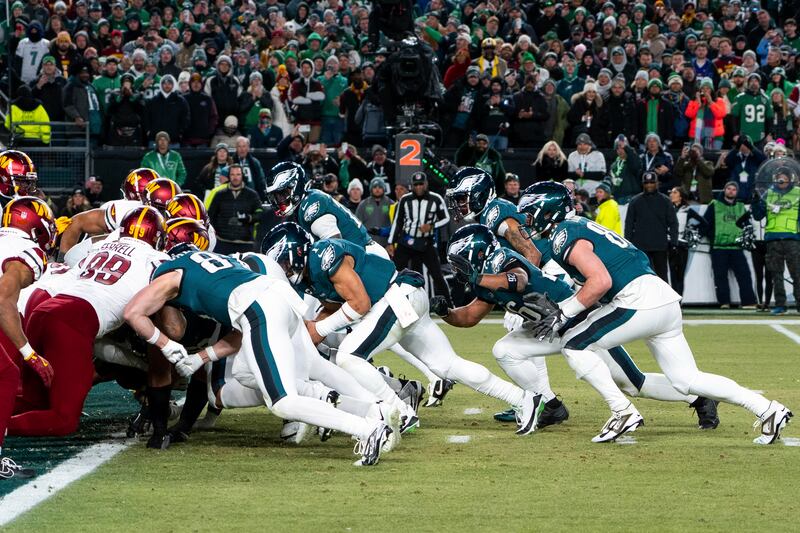Last week, for the second time in two months, the NFL considered banning its most infamous play.
The Tush Push will return in 2025, but you can be sure the issue will be raised again in the near future.
You remember the Tush Push, the short-yardage play in which offensive players line up in an old-fashioned rugby scrum and push a ball carrier through the defense. Put them in leather helmets and they will come full circle to the Flying Wedge (banned around 150 years ago).
The Philadelphia Eagles used the play very effectively in last season’s Super Bowl run. It was almost impossible to stop. The Eagles’ Tush Push has a 91.3% success rate since 2022, so it almost always means a first down or a touchdown. That’s as reliable as an extra-point kick — NFL kickers made good on 92.4% of their PAT kicks last season.
Jalen Hurts, the Eagles’ 223-pound quarterback, has generated 27 touchdowns and 92 first downs via the Tush Push over three years.
Both the Eagles and Bills make a living off the play. They ran the Tush Push more the past three seasons than the NFL’s other 30 teams combined, reports ESPN.
The majority of the league wants to get rid of the Tush Push, but a ban requires 24 votes by the owners.
When a proposal to ban the play came to a vote in April, it ended in a 16-16 tie. Team owners voted again last week, and this time the result was 22-10, two short of the required number of votes.
As Rich McKay, chairman of the NFL’s competition committee, told ESPN, “There are a bunch of teams that support it, committees that support it. It will be talked about again.”
The result of the vote was applauded by some. Sports Illustrated stated that to do otherwise was a vote against creativity; that it was a vote against owners who threw “tantrums” because their teams were unable to stop the play on the field; that the NFL should back out of “the murky business of play legislation;” that banning the play because it might cause an injury some day is “an incredibly dangerous precedent.”
Wrong.
In 2013, the NFL also engaged in the “murky” business of play legislation and banned defensive players from pushing their teammates into the offense – the Tush Push in reverse. No one complained. The reason for the rule change was “safety” – to protect the offensive line and long snapper from injury.
So, let’s see if we’ve got this straight. It’s a safety issue when the defense does it, but it’s not a safety issue when the offense does it.
Said McKay of the proposal to ban the Tush Push, “This was unanimously proposed by the competition committee, this was unanimously proposed by the player health and safety committee and by the owner health and safety committee. So there was a lot of support for it. A lot of discussion about it. ... Still takes 24 votes. In this case the votes were not there so the rule will stay as it is.”
College and high school rules state that an offensive player shall not push, pull or lift the runner to assist his forward progress. The NFL looks away.
Banning the play does not stifle creativity as much as stifle it.
The Eagles don’t have to be creative in short-yardage situations; they don’t have to throw the back-shoulder fade or run crossing routes and scrape off defenders or use motion to move the defense. Instead, they just plow straight ahead through the defense like Vikings behind a shield wall. It’s Neanderthal football. In the era of the pass game, it’s like they were enjoying a ballet and a cage fight broke out.
Besides all the other issues, it’s boring. The league has done everything it can to foster the passing game, and then they let this thing in the door? Who wants to watch a scrum of men lean into each other (for a short gain) like heavyweight boxers on the ropes in the final round?
The NFL has once again given the offense an unfair advantage, allowing offensive players to do something that is prohibited for defensive players.
The league already has gone to great lengths to favor the offense in an effort to boost scoring and passing. The hip-drop tackle is out. Players on both sides of the ball are prohibited from leading with the head, but it really applies only to the defense. Quarterbacks are a protected species — they are allowed to slide, or even fake slide, leaving defenders uncertain as to what they can do. Hit quarterbacks at your peril.
The league also created a legal version of intentional grounding for quarterbacks, and offensive linemen can extend their hands while blocking defenders, and pass interference rules make it all but impossible to defend receivers. Everything is about the passing game. They even stop the clock for an incomplete pass, encouraging more passing.
When the issue comes up again next year (and it will), let’s hope this time the league gives the Tush Push a push out the door.


